Published 11/11/2020
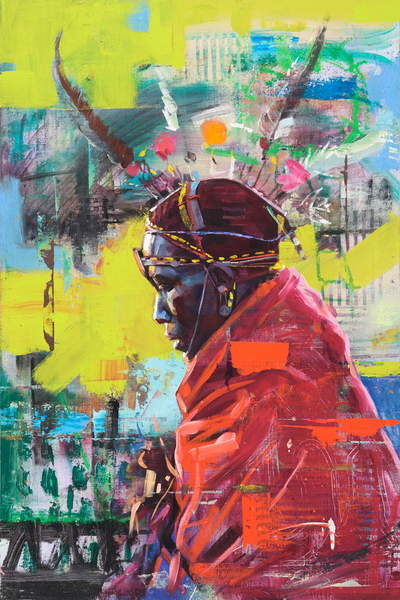
/ © Aaron Bevan-Bailey / Bridgeman Images
With a background in painting, Illustration and concept art, Aaron Bevan-Bailey brings a distinctively graphic style and confident vision to all of his work. Clients include Revlon, Vogue, Kit Kat, Oglvy, Saachi & Saachi, Mercedes, Now TV, Discover Dominica and Network Rail, Disney and many more. Our Artist manager Aretha interviewed Aaron, discussing his past and future projects and how he approaches his art.
1. You are both an artist and a filmmaker. When did you first start painting?
I've been painting ever since I could pick up a brush. It always felt like an itch that needed to be scratched for as long as I can remember. I am self taught and it never felt like a choice, more a necessity like if I didn't do it I would actually go insane or self destruct. I recently read a book on personality archetypes and according to my chart I am "The Observer." At first this pissed me off because I wanted to be something cooler like the "unabashed extrovert" but it actually made a lot of sense to me because I've always felt a sense that I see the world in finer detail than a lot of other people. This can be good and bad and sometimes its something that would be nice to be able to turn off. I feel like people that think in broader strokes probably have more fun. I think that it is the job of an artist to use that sensitivity to extract meaning from the world and hopefully translate it for others to see so they can expand their own understanding.
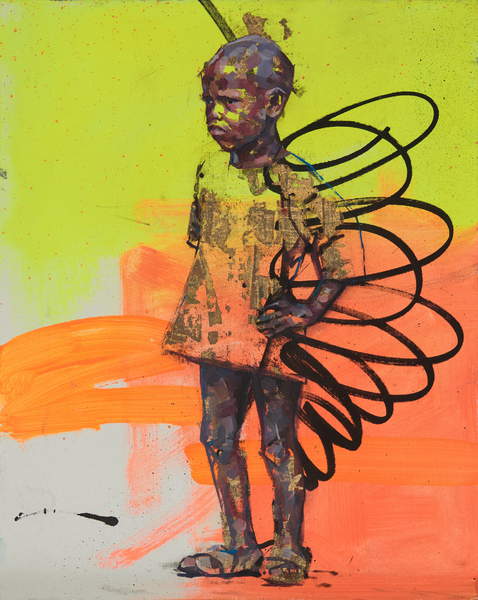
/ © Aaron Bevan-Bailey / Bridgeman Images
2. What is your favourite time of the day to be in your studio?
I usually get to the studio at about 1pm. I feel like my juices don't start flowing until then. I don't really have a favourite time but I do my best work when I'm able to switch off conscious thought and channel it. This sometimes happens when I'm a little tired or spaced out and the chatter in my head gets quieter. I've always found it quite easy to achieve that state, probably to the detriment of other areas of my life. When I'm painting or drawing especially from life I fall into a state of meditation or self hypnosis to the point where I find it hard to speak to people straight after. It is a place without words or time and sometimes I wish I could stay in that circle of creation forever. I like working late at night when everyone else has gone to bed, there's less distractions either real or perceived and it feels like there are less people around to use up the good ideas.
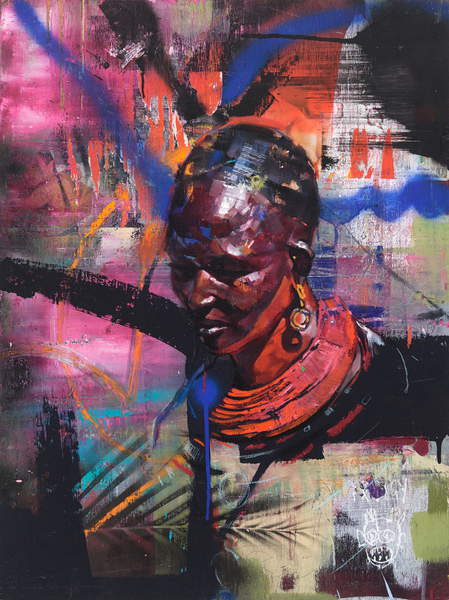
/ © Aaron Bevan-Bailey / Bridgeman Images
3. You are firmly established as both a painter, photographer and director. How do your different practices influence one another?
I think they all exercise a similar muscle but there are feelings and atmospheres that can only be expressed in specific mediums. Life drawing definitely improves my portrait photography, I instinctively move myself to the angle I would like to draw the subject from when I take the picture. The film work feeds into the photography too because I'm always searching for a sense of atmosphere and implied narrative in my photos. My favourite photographers always capture a feeling that their shots are part of an ongoing story. I feel like it elevates the medium from the two dimensional to something more interactive, the more work your imagination needs to do, the longer an image stays with you. I love street photography because there is the element of chance, something unrepeatable. I feel like those images come and find me rather than the other way around I just need to stay open enough to receive them. They often become the subject of my paintings and the randomness helps me beat creative blocks. Sometimes I will travel to the studio without a plan and someone I pass on the bus will be a painting by the end of the day.
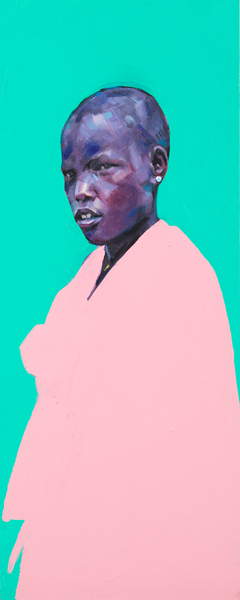
/ © Aaron Bevan-Bailey / Bridgeman Images
I love working in film when I am directing a crew of thirty plus people and they are all looking to you for answers and the budget means you have a very limited amount of time to realise your vision. My brain feels fizzy like it's really running at full capacity. It's quite rare that you get that feeling in life. I worked as an art director before I started Directing. Creating an alternate reality always fascinated me. My parents were both dancers and my father would work as an usher in theatres. When I was younger and I would come to London to stay with him, I spent a lot of time hanging out backstage. I was always equally fascinated by the shows themselves and the smoke and mirrors that went into creating them. The foundation of all my work comes from painting and drawing. It is here that I honed my eye for light, composition and emotion. I like to keep all three in conversation with each other. I think it keeps it fresh.
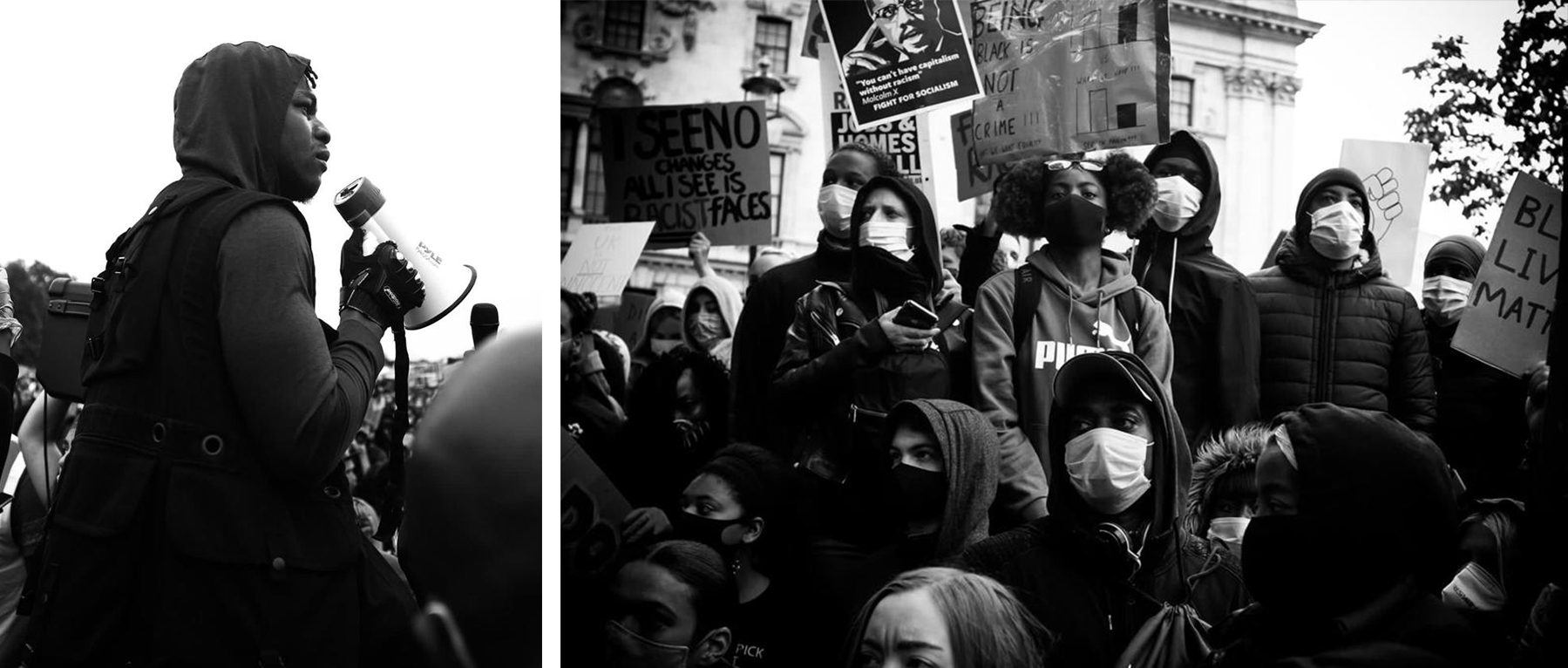
4. You documented the Black Lives Matter march in London this summer, what was that like to both be part of it and document it?
It was an extremely emotional time for me and all black people I think. It felt like a cultural awakening that I haven't witnessed before in my life. It felt like white people were actually listening and the diversity of the crowds reflected that. The Corona virus somehow pushed people to consider that living on this planet is a shared experience and there is a huge disparity within that experience. The pandemic also had an effect on the actual images I was taking; the fact that everyone was wearing masks meant that only their eyes were visible. This had the effect of condensing the emotion in peoples faces into a visceral primal connection which I'm not sure I would have got without them.
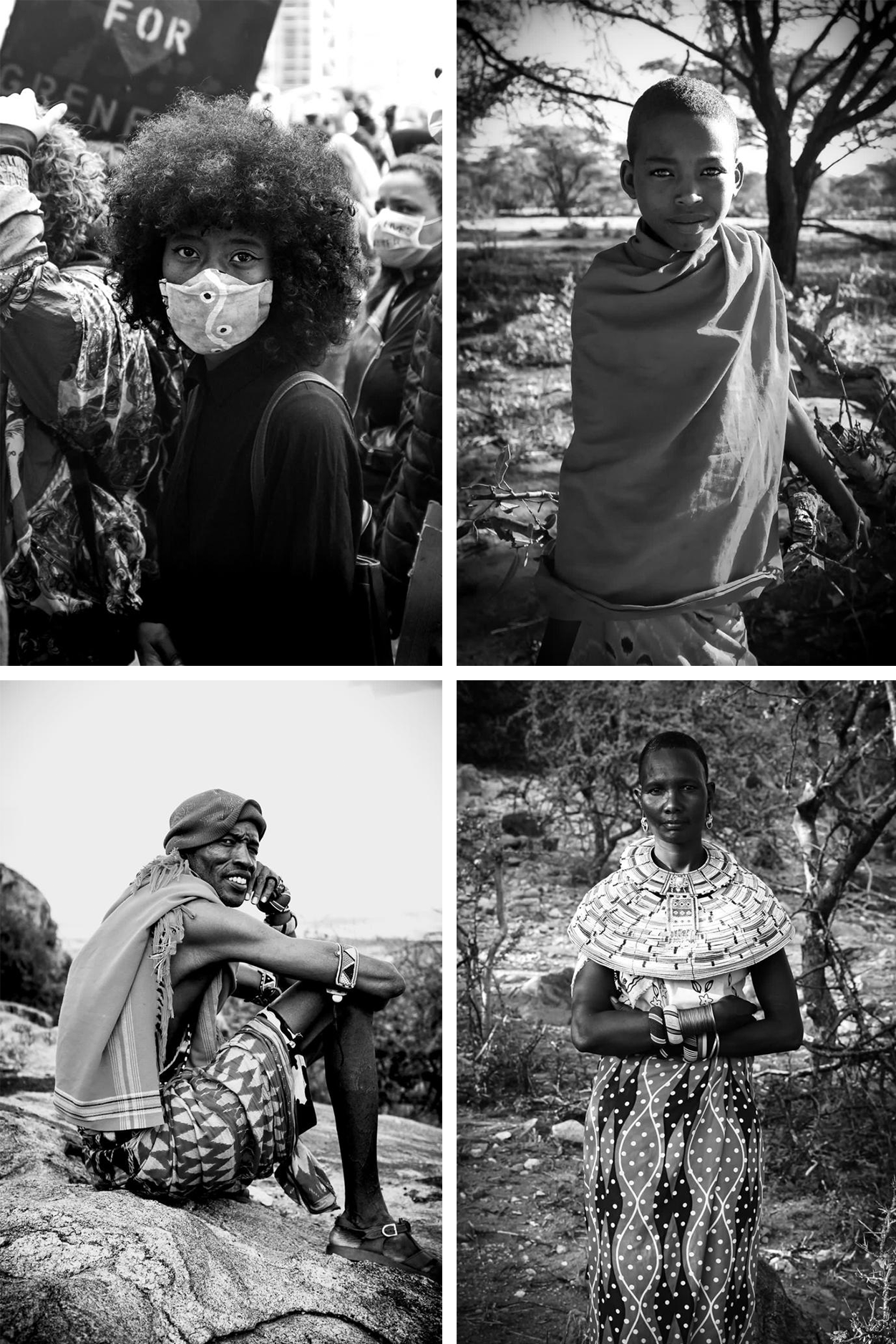
In less plague-y times I'm obsessed with street photography. It helps me slow down the pace of life in London and look deeper into the contrast and drama playing out around us all the time. It helps me to process life. When we went into lockdown it felt like that aspect of my life had been ripped away from me because London was a ghost town. I didn't realise how much I had taken constant human traffic for granted. The BLM protests happened. I had only left my house to shop and exercise for the last few months and suddenly it was like a tidal wave of people and subject matter that is extremely close to my heart.
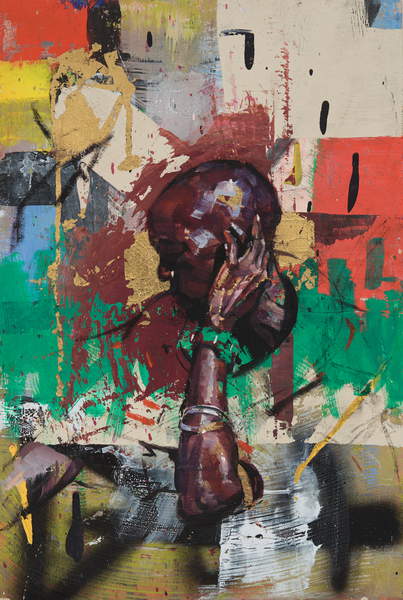
/ © Aaron Bevan-Bailey / Bridgeman Images
5. When you are undertaking a portrait commission, what do you find most challenging, what is your process?
In figurative art I'm conscious that I'm working in an area that some people think is stale and old fashioned. I am always looking to find the humanity in someone rather than the majesty. I don't want to produce a straight backed traditional portrait. I think there is much more personality in a casual slump or gesture. It is the same inner sanctum I'm looking for in my photos. The most challenging thing is trying to capture someone's personality when you don't know them that well. I usually try to do a preliminary sketch or photo session in person. Even if it doesn't become the basis for the painting it allows me to learn a lot about them. Whether they embrace the process, are resistant to it, whether they want to be in control of it. It tells you a lot about them. The discomfort of being studied usually gets people to talk to break the tension which if you're lucky, will uncover some gems of their deeper self. Above all I want to make my paintings an honest expression not a compliment.
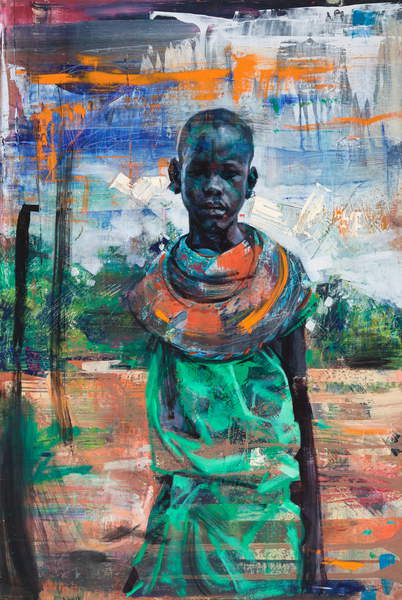
/ © Aaron Bevan-Bailey / Bridgeman Images
6. Your most recent series of work is inspired by your time in Africa, where and why were you there?
Spending time with the Samburu Masai tribe in Kenya was a spiritual awakening for me. It restored my faith in humanity: that there were still people living on earth capable of being what I consider truly human. Their lack of pretentiousness and devotion to nature and protecting it at the heart of their culture was unlike anything I've seen before. My contact there, James Lakililie cheif of the Lakililie clan described their philosophy as "First respect the ground you are stepping on, then you can respect yourself then you can fully respect the people around you." I like that. If you take part in any ritualistic meditative group practice you will have heard the term "Holding space". In the tribe their lives are steeped in prayer, ritual and ceremony and they hold space for each other continuously. At first this makes you feel quite exposed because you are used to meeting people through so many layers of meaningless bullshit. It is not often someone looks at you directly in your essence, someone who has been through initiations and faces life threatening tests on a daily basis, who has such a clear sense of purpose and identity and asks you who you are. They are not asking for a bunch of pop culture reference points and brands you are into, they actually want to know. It forces you to ask the same question.
I am mixed race Jamaican and Scottish and growing up in the UK I was always taught my history began and ended with slavery and before that Africans were mindless savages. This is obviously something I knew in my heart was not true. All the imagery we get in the west of Africa is poverty, war and starvation. It isn't until you get there and experience the warmth and beauty of the African people that you realise those are just a tiny part of the multifaceted jewel that is Africa. When I touched the soil and experienced the rich Pre-Christian African culture and spirituality for myself I was able to truly grasp what me and my father's ancestors had lost. I felt reconnected, I wish it was an experience the whole African diaspora could have. It fulfils something at an epigenetic level that has to be felt to be understood.
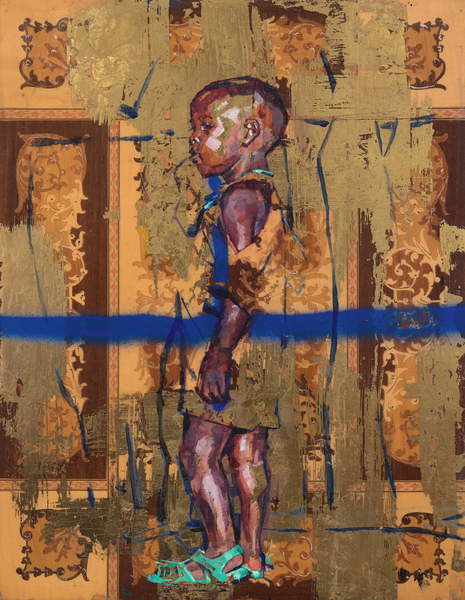
/ © Aaron Bevan-Bailey / Bridgeman Images
The Masai language Mar has no written characters, knowledge is passed on verbally from one person to another and in this tradition the elders and their library of stories and wisdom take on special significance. Being nomadic herdsmen this minimalism and efficiency is borne out across other aspects of Samburu life. Material possessions do not hold the same value, they become dead weight as they make long migrations to greener pastures for their livestock. At night Lolpatai, a Samburu elder led us in prayers around the fire to ask for the blessings of Ngai (the Samburu word for God/nature). As the fire crackled and the crickets sang, I closed my eyes and listened to his voice. I could picture my ancestors in the same scene a thousand years ago. His words felt like they had the ability to heal and in those moments I understood the power of the oral tradition.
There is something deep in our collective humanity, black or white baked into the soil in Africa. It is the source.
7. You have worked with an amazingingly diverse selection of clients, what commissions have you most enjoyed?
My favourite commission was actually of my grandmother for my uncle. The more personal paintings are, the more I enjoy making them. She is 95 this year and has quite severe dementia. Her ability to make new memories extends about 10 minutes into the past. You would think this would create a constant state of fear and confusion but she remains her old positive cheerful self. My theory is that she has found a way to live almost exclusively in the present moment. She asks me the same question five times in 15 minutes then turns round and tells a story from the 1940s. I'm fascinated by what her experience must be like so I attempted to paint this fog she sees through. This got me to thinking, what are we when we remove our stories, our memories? When my mother died one of the most painful feelings was that someone had burned the encyclopaedia of my childhood. Sure I had memories of my childhood, but because it was just me and her growing up, I had no one left to corroborate them. As I have grown older this feeling has morphed into something else. I feel her with me, if you want to be scientific about it, her very DNA lives inside my body, she is me.
Through psychedelic experiences, namely with DMT I have recognised ego or personality is directly tied to the narrative we tell about ourselves. But it is just that, a narrative. I am not going to try to carve a description of the majesty of that experience with the blunt chisel of human expression but I will say this: when you can remove the conscious tether to your narrative you realise there is no difference between you and someone else or any other living thing. We are all part of the same energy. Eckhart Tolle says Ego and awareness cannot coexist. I don’t know if I'm there yet but I am becoming aware of what my ego is.
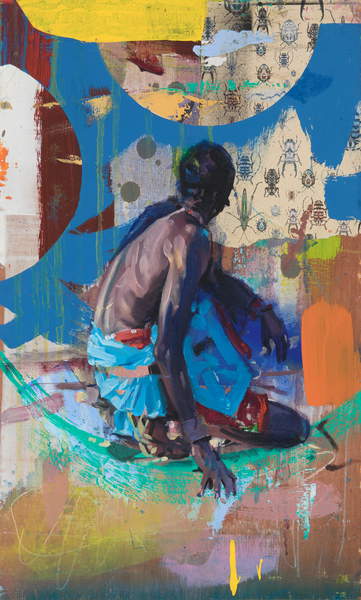
/ © Aaron Bevan-Bailey / Bridgeman Images
8. Finally, If you could invite 7 people from history to dinner, who would they be and why?
Basquiat, Angela Davis,Nelson Mandela, David Attenborough, Prince, John Singer Sargent.
Basquiat because I feel like I would like to be him. He was the coolest of the cool. His work gives you a sense of such an agile mind jumping from one idea to the next. Editing and redacting. Dark but playful. He also opened so many doors for people like me to one day be taken seriously as artists.
I'm probably over romanticising but If I could travel back to any time period it would be NY in the late 70s early 80s. It feels like it was such an explosion of ideas, Disco, punk, the inception of Hip Hop. Street art was a new idea, Keith Harring was tagging the subway, Studio 54 . . .
Angela Davis because she represents something even more dangerous and threatening to the white establishment than the black man, the intelectual black woman. The strength and courage it took for her to stand up the way she did at the time she did, in the face of death threats and the full weight of the FBI pressing down on her will forever have my awe and respect.
Nelson Mandela because he is one of my personal heroes. He was imprisoned for 27 years, 18 of which he spent in a tiny cell without bed or plumbing and rose to become the Prime minister of South Africa. I feel people who have tasted the full spectrum of the human experience take on a guru-like quality. Those are the kind of people I want to learn from.
David Attenborough because he has been everywhere and seen every natural wonder on earth. Ive always thought he'd be the ultimate dinner party guest.
Prince because I mean... come on, its Prince.
Sargent because I would have so many technical questions about oil painting and his technique. I love his work so much - I would be intrigued to see what kind of person he was.

Please click here to view our currently available selection of Aaron Bevan-Bailey images, including his artwork and photography.


